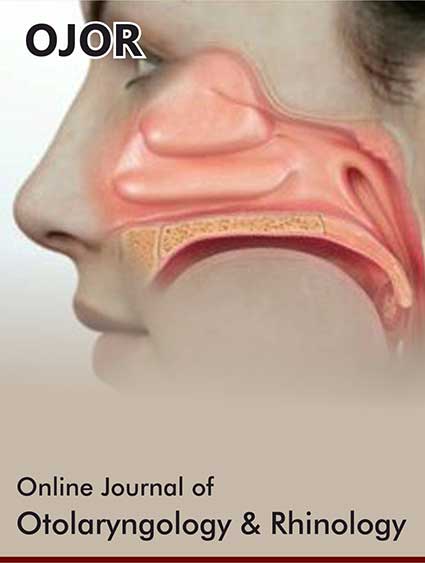 Case Report
Case Report
EBV+T Lymphocyte Proliferative Disease was Diagnosed after Tonsillectomy in Children
Xianghua LI¹, Dongfei WANG² and YunPeng BA1*
1Department of Rhinology, The First Affiliated Hospital of Zhengzhou University, Zhengzhou 450000, China
2Department of Information Technology, The First Affiliated Hospital of Zhengzhou University, Zhengzhou 450000, China
YunPeng BA, Department of Rhinology, The First Affiliated Hospital of Zhengzhou University, Zhengzhou 450000, China.
Received Date: November 28, 2024; Published Date: December 04, 2024
Abstract
Objective: To explore the clinical characteristics, diagnosis, treatment, and prognosis of children with EBV-related T cell lymphoproliferative diseases.
Methods: We report a case of a child diagnosed with EBV+ T cell lymphoproliferative disease after tonsillectomy and review relevant literature.
Results: The child presented with tonsillar hypertrophy, which led to sleep apnea. Pathological examination revealed T cell tissue proliferation accompanied by EBV infection, suggestive of EBV-related T cell lymphoproliferative disease (Grade I or Grade II).
Conclusion: EBV-related T cell lymphoproliferative disease in children is a life-threatening condition characterized by high fever, hepatosplenomegaly, and lymphadenopathy. There is currently no consensus on the treatment of this disease, but antiviral, corticosteroid, and chemotherapy methods can effectively control symptoms.
Keywords: Tonsillectomy; EBV+ T cell lymphoproliferative disease
Introduction
EBV is a common lymphotropic herpesvirus that infects approximately 90% of the world’s population [1]. It can cause chronic latent infection in human hosts for life [2]. In general, it does not cause severe complications, but in immunocompromised individuals, EBV can lead to serious diseases such as B cell lymphomas, nasopharyngeal carcinoma, gastric cancer, and mature T cell lymphomas [3, 4]. While EBV typically infects oropharyngeal epithelial cells and B cells, there have been reports of the virus infecting T cells and rare cases of tonsillar T cells and NK cells in children [5, 6].
Medical History
We admitted a 3-year-old boy who had been snoring and mouth breathing for more than 2 months. He experienced snoring, mouth breathing, apnea, nasal congestion, sneezing, and hearing loss during sleep. He did not have cough, fever, headache, or decreased sense of smell. He had been treated with azithromycin (0.05g/ day) and montelukast sodium chewable tablets (2.5mg/day) at a local hospital, but the symptoms did not improve. He was initially diagnosed with pediatric snoring, sinusitis, and serous otitis media and was admitted to our hospital. Upon admission, the patient was alert, had a normal appetite, and had a height and weight comparable to children of the same age.
Ear, nose, and throat examination revealed clear external ear canals without granulation or purulent discharge, intact tympanic membranes, normal nasal septum slightly deviated to the left, bilateral hypertrophy of the inferior nasal turbinates, and normal nasal mucosa. The pharynx showed no congestion, and the tonsils were grade II. Additional examinations, including nasal sinus CT (as shown in Figure A and B), were performed. The patient underwent “adenoid cryoablation under nasal endoscopy + bilateral tonsillectomy + bilateral myringotomy with tube placement” surgery. After the surgery, the patient had persistent fever, with a maximum temperature of 41 degrees Celsius. He was treated with anti-inflammatory, antiviral, and antipyretic medications, but the fever persisted.

Pathological examination of the postoperative specimens (tonsils and adenoids) revealed T cell tissue proliferation accompanied by EBV infection. Combined with clinical, morphological, and immunohistochemical findings, the diagnosis of EBV-positive T cell lymphoproliferative disease was considered, and further diagnosis using TCR gene rearrangement was recommended. Immunohistochemical results showed AE1/AE3 (CK) (epithelial+), CD20 (foci+), CD21 (FDC), CD3 (+), CD79α (foci+), CD5 (+), CD10* (germinal center+), Bcl-2 (germinal center+), Bcl-6 (germinal center+), CyclinD1 (-), Ki-67 (40%+), MUM-1 (scattered+), ALK(5A4) (-), CD30 (scattered+), CD2 (+), CD7 (+), CD4 (+), CD8 (partially+), TIA-1 (+), GranzymeB (few+), CD56(56C04)* (-), EBNA2* (NS). EBER in situ hybridization was positive with 100/ HPF. Over the past month, laboratory tests showed elevated lymphocytes, monocytes, and decreased neutrophils (as shown in Table 1). EBV DNA, cytomegalovirus DNA, and human herpesvirus DNA were detected in the blood, with consistently high EBV virus test results (as shown in Table 2).
Table 1:Changes in blood routine of the patient.

Table 2:EB virus test results.

Liver function, electrolytes, and coagulation function were normal. Whole-body lymph node ultrasound showed multiple enlarged lymph nodes with unclear demarcation between the cortex and medulla, thickened cortex, reduced medulla, and the largest lymph node located in the right cervical II region measuring approximately 23mm 11mm with I-level blood flow signal detected by color Doppler flow imaging (CDFI). The largest lymph node on the left side was located in the left cervical II region and measured approximately 28.4mm15.4mm with I-level blood flow signal detected by CDFI. No obvious abnormal lymph node enlargement was found in the inguinal region. Peripheral blood smear showed elevated white blood cell count, decreased neutrophil ratio, increased lymphocyte ratio, and 30% atypical lymphocytes. The pathological results indicated EBV+ T cell lymphoproliferative disease.
Detailed inquiry with the patient’s family revealed that the child had experienced intermittent recurrent fever since six months of age, and hospitalization with antibiotic treatment resulted in improvement. We suspected that the child had chronic EBV infection. The current diagnosis of the patient is EBV+ T cell lymphoproliferative disease.
Treatment
We initially treated the patient with corticosteroids, antivirals, and anti-inflammatory drugs, and the fever gradually improved over a period of two weeks after the surgery. The temperature changes are shown in Table 3. However, the patient developed fungal infection in the ears and “canker sores,” and treatment with fluconazole ear drops did not improve the symptoms. Fungal testing and culture of ear secretions showed elevated fungal infection indicators, prompting a switch to intravenous antifungal therapy while continuing antiviral and supportive treatment for organ function. Two weeks later, the fungal indicators decreased compared to before, and there was no recurrence of fever. The family requested discharge.
Table 3:Postoperative temperature changes in the patient.

Discussion
EBV-related T cell lymphoproliferative disease is a lifethreatening condition characterized by clonal proliferation of EBVinfected T lymphocytes with an activated cytotoxic phenotype. It is more common in Asian children and adolescents, with a median age of diagnosis around 8 years old [7, 8].This disease can affect various organs, with lymph nodes and liver and spleen involvement being common [9]. In this case, there were no abnormalities in the liver and spleen, but multiple lymph nodes were enlarged. The clinical manifestations mainly include high fever, hepatosplenomegaly, and lymphadenopathy, often accompanied by hemophagocytic syndrome [10, 11]. The patient in our report had a history of intermittent recurrent fever since six months of age, and persistent high fever. This admission examination revealed cervical lymphadenopathy, but no abnormalities were found in the liver, gallbladder, spleen, or pancreas. EBV-related T cell lymphoproliferative diseases in children include chronic active EBV infection (CAEBV) and systemic EBV+ T cell lymphomas. CAEBV is characterized by persistent infectious mononucleosis- like symptoms [12]. The patient in this report had elevated monocyte levels in both the admission and postoperative examinations. Therefore, the patient should be considered to have chronic active EBV infection, which is a subtype of EBV-related T cell lymphoproliferative disease in children. Diagnosis requires a combination of clinical manifestations, laboratory tests, and pathological results. Routine pathology and immunohistochemistry are the most accurate methods for diagnosing EBV+ T cell lymphoproliferative disease. The etiology and pathogenesis of EBV+T cell lymphoproliferative disease are still unclear, and there is currently no consensus on the treatment. Hematopoietic stem cell transplantation may be the most effective method for this disease [13]. In the early stages of the disease, antiviral therapy, corticosteroid therapy, and chemotherapy have been reported to effectively control symptoms [14]. In our case, although we controlled the fever, the patient developed long-term and chronic fungal infection. Considering the potential complications and uncertainty of treatment with chemotherapy, we did not use this method for the patient. EBV+ T cell lymphoproliferative disease can lead to life-threatening complications [15], such as malignant lymphomas, liver failure, interstitial pneumonia, coronary artery aneurysms, central nervous system involvement, hemophagocytic syndrome, and gastrointestinal bleeding [16]. Most cases progress rapidly, and patients may experience multiple organ failure and sepsis within days to weeks after diagnosis, ultimately leading to death. However, in some cases, symptoms can persist into adulthood [17]. For patients without obvious clinical symptoms, conservative treatment is recommended by some experts.
Although there have been many reports on EBV+ T cell lymphoproliferative disease in China, research in the field of otolaryngology is limited, especially in cases where the disease is discovered after the diagnosis of pediatric snoring. We hope that this case can provide some inspiration to otolaryngologists, urging them to consider other possibilities in the evaluation of feverish children, in addition to chronic tonsillitis.
Informed Consent
The report has been approved by the patient’s family and approved by the ethics Committee of the hospital.
Acknowledgement
None.
Conflict of Interest
No conflicts of interest.
References
- Cohen JI, Fauci AS, Varmus H (2011) Epstein-Barr virus: an important vaccine target for cancer prevention. Sci Transl Med 3: 107fs7.
- Taylor GS, Long HM, Brooks JM, Rickinson AB, Hislop AD (2015) The immunology of Epstein-Barr virus-induced disease. Annu Rev Immunol 33: 787-821.
- Tang LL, Chen WQ, Xue WQ (2016) Global trends in incidence and mortality of nasopharyngeal carcinoma. Cancer Lett 374: 22-30.
- Bray F, Ren JS, Masuyer E (2013) Global estimates of cancer prevalence for 27 sites in the adult population in 2008. Int J Cancer 132: 1133-1145.
- Cohen JI, Fauci AS, Varmus H (2011) Epstein-Barr virus: an important vaccine target for cancer prevention. Sci Transl Med 3: 107fs7.
- Young LS, Rickinson AB (2004) Epstein-Barr virus: 40 years on. Nat Rev Cancer 4: 757-768.
- Quintanilla Martinez L, Ridaura C, Nagl F (2013) Hydroa vacciniforme-like lymphoma: a chronic EBV+ lymphoproliferative disorder with risk to develop a systemic lymphoma. Blood 122: 3101-3110.
- Sangueza M, Plaza JA (2013) Hydroa vacciniforme-like cutaneous T-cell lymphoma: clinicopathologic and immunohistochemical study of 12 cases. J Am Acad Dermatol 69: 112-119.
- Gonzalez Farre B, Rovira J, Martinez D (2014) In vivo intratumoral Epstein-Barr virus replication is associated with XBP1 activation and early-onset post-transplant lymphoproliferative disorders with prognostic implications. Mod Pathol 27: 1599-1611.
- Gruhne B, Sompallae R, Masucci MG (2009) Three Epstein-Barr virus latency proteins independently promote genomic instability by inducing DNA damage, inhibiting DNA repair and inactivating cell cycle checkpoints. Oncogene 28: 3997-4008.
- Swerdlow SH, Campo E, Pileri SA (2016) The2016 revision of the world health organization classification of lymphoid neoplasms. Blood 127: 2375-2390.
- Cohen JI, Kimum H, Nakamum S (2009) Epstein-Barr virus-associated lymphopmliferative disease in non-immunocompromised hosts:a status report and summary of international meeting,8-9, September 2008. Ann Oncol 20(9): 1472-1482.
- Matsui S, Takeda Y, Isshiki Y, Yamazaki A, Nakao S, et al. (2016) Chronic active Epstein-Barr virus infection with marked pericardial effusion successfully treated with allogeneic peripheral blood stem cell transplantation. Rinsho Ketsueki 57: 624-629.
- Zeng X, Wei N, Wang Y, Wang J, Zhang J, et al. (2015) Treatment outcomes and prognostic analysis of 61 Epstein-Barr virus-associated hemophagocytic lymp hohistiocytosis. Zhonghua Xue Ye Xue Za Zhi 36: 507-510.
- Xing Y, Yang J, Lian G, Chen S, Chen L, et al. (2017) Chronic active Epstein-Barr virus infection associated with hemophagocytic syndrome and extra-nodal natural killer/T-cell lymphoma in an 18-year-old girl: A case report. Medicine 96: e6845.
- Rolinski J, Grywalska E, Pyzik A, Dzik M, Opoka Winiarska V, et al. (2018) Interferon alpha as antiviral therapy in chronic active Epstein-Barr virus disease with interstitial pneumonia - case report. BMC Infect Dis 18: 190.
- Kuo TT, Shih LY, Tsang NM (2004) Nasal NK/T cell lymphoma in Taiwan: a clinicopathologic study of 22 cases, with analysis of histologic subtypes, Epstein-Barr virus LMP-1 gene association, and treatment modalities. Int J Surg Pathol 12: 375-387.
-
Xianghua LI, Dongfei WANG and YunPeng BA. EBV+T Lymphocyte Proliferative Disease was Diagnosed after Tonsillectomy in Children. On J Otolaryngol & Rhinol. 7(2): 2024. OJOR.MS.ID.000660.
-
Tonsillectomy, EBV+ T cell lymphoproliferative, Otolaryngology, Chronic tonsillitis, Fungal infection, Pathological results, Hemophagocytic syndrome, EBV infection, Lymph nodes
-

This work is licensed under a Creative Commons Attribution-NonCommercial 4.0 International License.






